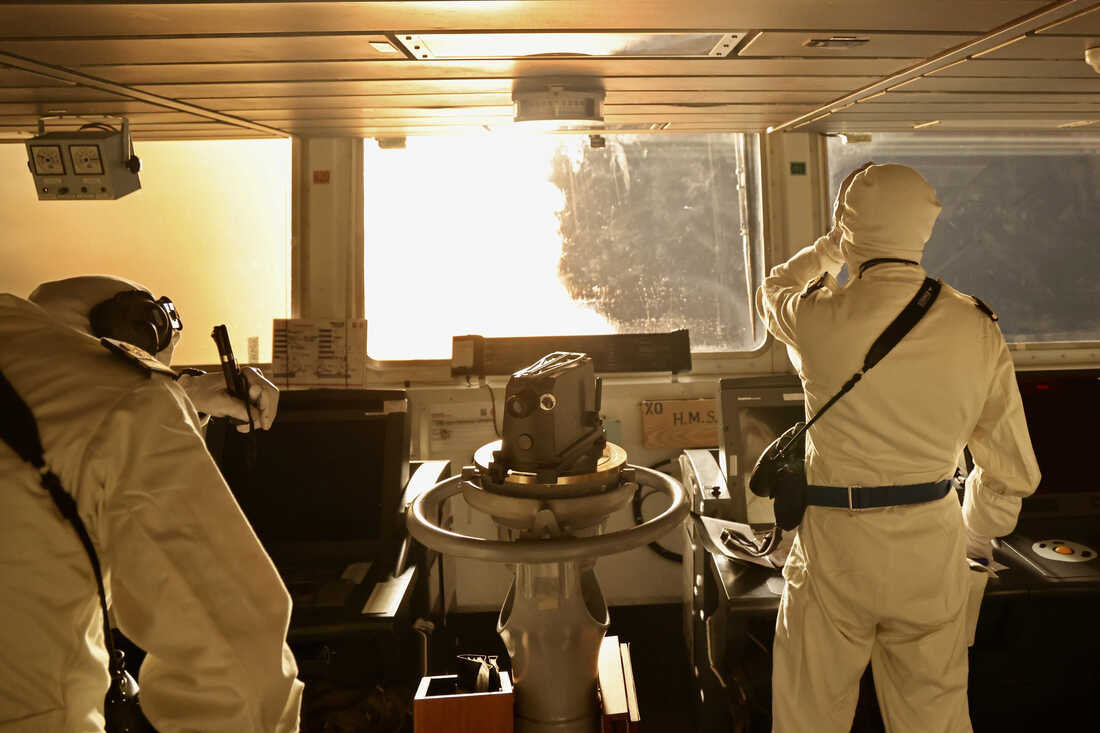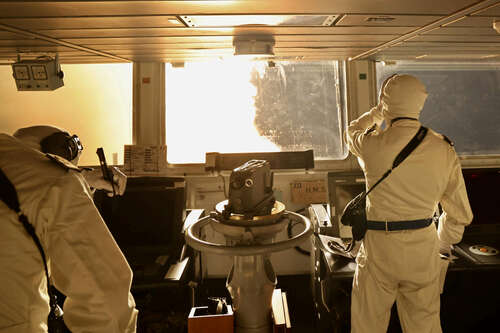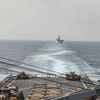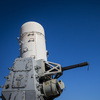
Image taken from the bridge of HMS Diamond, seen here firing Sea Viper missiles in the Red Sea on Oct. 1. The HMS Diamond along with U.S. warships successfully repelled a large attack from the Iranian-backed Houthis in the Red Sea.
UK MOD/Sipa USA via Reuters Conn
hide caption
toggle caption
UK MOD/Sipa USA via Reuters Conn

Image taken from the bridge of HMS Diamond, seen here firing Sea Viper missiles in the Red Sea on Oct. 1. The HMS Diamond along with U.S. warships successfully repelled a large attack from the Iranian-backed Houthis in the Red Sea.
UK MOD/Sipa USA via Reuters Conn
The United States and Britain launched strikes on about a dozen Houthi militant targets in Yemen, according to a U.S. defense official, speaking on condition of anonymity. The strikes follow more than two months of attacks by the Houthis against international cargo ships and U.S. warships in the Red Sea, expanding a Middle East conflict U.S. officials have worked hard to contain.
In a written statement, President Biden stressed that the joint attacks were a defensive response to Houthi actions, and had the support of Australia, Bahrain, Canada and the Netherlands.
“These targeted strikes are a clear message that the United States and our partners will not tolerate attacks on our personnel or allow hostile actors to imperil freedom of navigation in one of the world’s most critical commercial routes,” Biden said. “I will not hesitate to direct further measures to protect our people and the free flow of international commerce as necessary.”
The defense official told NPR the strikes were carried out using surface ships and submarines as well as Navy ship-based warplanes and Air Force attack aircraft, in addition to British aircraft. The targets include radar sites, drone launchers and drone storage sites — chosen in an effort to “degrade” the Houthis’ ability to attack shipping.
The Biden administration has been telegraphing possible retaliation against the Iranian-backed Houthi militants for days, with one senior official saying the Houthis would face “consequences” if the attacks continued. The official said Biden met with his national security team on New Year’s Day to discuss options.
Since November, the Houthis have targeted international cargo ships in the Red Sea, mounting more than two dozen drone and missile attacks. Some of the attacks have damaged ships, although U.S. warships have shot down many of the missiles and drones.
On Jan. 9, the Pentagon said Houthis launched the largest attack yet, firing one-way drones, anti-ship cruise missiles and an anti-ship ballistic missile into the Southern Red Sea, toward international shipping lanes where dozens of merchant vessels were transiting.
Eighteen drones and missiles were shot down by a combined effort of F-18 aircraft from the USS Dwight D. Eisenhower as well as strikes from the USS Gravely, the USS Laboon, the USS Mason and the United Kingdom’s HMS Diamond. It was the 26th Houthi attack on commercial shipping lanes in the Red Sea. There were no injuries or damage reported.
Before that four small Houthi boats tried to attack a container ship, the Singapore-flagged Maersk Hangzhou, which officials said was either a hijacking attempt or a suicide mission. U.S. helicopters from the USS Dwight D. Eisenhower and USS Gravely responded, and when they took fire from the Houthi boats, opened fire, sinking three boats while the fourth one escaped. The Houthis said they lost at least 10 fighters.
The U.S. attacks on Yemen soil come after some Republicans have strongly pushed for retaliation against the Houthis.
Republican Rep. Mike Turner of Ohio, chairman of the House Intelligence Committee, said recently on ABC’s This Week that the Biden administration must take a tougher stance against the Houthi militants.
“Well, what I think what’s significant is the administration continues to not respond to the Houthi escalation in the area,” Turner said.
And Sen. Roger Wicker of Mississippi, the top Republican on the Armed Services Committee, chided Biden.
“This is a global crisis brought on by weak presidential leadership,” Wicker said in a news release on Jan. 4. “It is time for President Biden to allow our regional commanders the freedom of action they need to end terrorist behavior by the Houthis.”
One former U.S. regional commander, retired Marine Gen. Frank McKenzie, who served as the top officer in the Middle East, said in a Wall Street Journal opinion piece last week that it was time to act against the Houthis, and send a message to Iran.
“Tehran and its proxies are pressing their attacks because they haven’t confronted steel,” McKenzie wrote. “The ability to stop such probing generally depends on a swift and violent counterattack.”
Now that there has been such a counterattack, what does the future hold?
Behnam Ben Taleblu, who focuses on Iranian security and political issues at the Foundation for Defense of Democracies, a nonprofit think tank in Washington, wonders whether the U.S. strikes were designed to send a message or lead to a broader assault.
The Houthis — more so than other Iranian-supported groups, like the Palestinian group Hamas or Hezbollah in Lebanon — have a sophisticated arsenal of weapons provided by Iran, he says, including medium-range ballistic missiles capable of reaching southern Israel as well as an array of drones.
The U.S. would have to mount a “sustained” campaign against the Houthi military sites, he said, if it wants to “defang” the group.
Wary shipping companies
This is not the first time the U.S. has attacked Houthi targets in Yemen. Back in 2016, the U.S. launched three cruise missiles against coastal radar sites after failed Houthi missile attacks on a U.S. destroyer.
The recent and repeated Houthi attacks on shipping in the Red Sea have led to the recent creation of a naval coalition — dubbed Prosperity Guardian — led by the U.S. and including some two dozen countries to provide security for the shipping companies.
But some of the companies are still wary, bypassing the dangers of the Red Sea and instead making a longer trip around Africa to reach Europe.
“The situation is constantly evolving and remains highly volatile, and all available intelligence at hand confirms that the security risk continues to be at a significantly elevated level,” the shipping giant Maersk said in a statement on Jan. 5. “We have therefore decided that all Maersk vessels due to transit the Red Sea / Gulf of Aden will be diverted south around the Cape of Good Hope for the foreseeable future.”
The U.S. says the Houthi attacks are nothing more than an assault on international shipping in a waterway that hosts as much as 15% of the world’s trade.
Houthis counter by saying the ongoing attacks are in solidarity with Hamas militants who mounted an attack on Israel on Oct. 7. Hamas killed 1,200 people, mainly civilians, and took about 240 hostages, Israeli officials say.
Israel responded with an offensive in the Gaza Strip it says is meant to destroy Hamas, which rules the territory. Israel’s air, ground and sea assault has led to more than 23,000 deaths in Gaza, according to health officials there, with most of those killed women and children.
Now the counterattacks on the Houthis have widened a conflict in the Middle East, that was spurred by the Hamas attack on Israel. The U.S. has urged Israel to wrap up its incursion into Gaza, or at least stop the intense bombing that has led to a large number of civilian deaths and a humanitarian catastrophe.
A steady stream of U.S. officials — from Secretary of State Antony Blinken to national security adviser Jake Sullivan to Defense Secretary Lloyd Austin — have all pressed for a more targeted ground campaign, protection of civilians and an increase in humanitarian aid to Gaza.
But Israel has said it will continue its campaign until Hamas is defeated, with officials saying that effort could last well into this year.
Regional shockwaves
Even before the U.S. strikes in Yemen, the Middle East conflict was expanding. Iranian-backed militias have continued attacks on U.S. forces in Syria and Iraq, with the Pentagon logging some 120 attacks since October. A recent assault in Irbil, Iraq, left three U.S. service members wounded, one critically with a head wound from shrapnel.
And after its attack on Gaza, Israel has exchanged fire with Iranian-backed Hezbollah fighters in Lebanon and more recently killed a senior Hamas official in Beirut.
The United States, meanwhile, killed a senior Iranian-affiliated militia leader in Baghdad, Mushtaq Talib al-Saidi, also known as Abu Taqwa, who the U.S. says was behind attacks on its forces in the country. The attack incensed some Iraqi leaders who said the killing violated its sovereignty and raised questions about ongoing U.S. presence.
With the latest U.S. attack on Yemen, what will it mean for Iranian-proxies in the region? Will they increase their attacks on shipping or U.S. troops? Will Iran get more involved? Already Iran has a sent a frigate into the Red Sea.
And will Yemen look to open another front — maybe against Saudi Arabia?
The Saudi-backed Yemeni government and the Iran-aligned Houthis have been locked in a conflict since 2015, a fight that has killed hundreds of thousands and left some 80% of Yemen’s populations dependent on humanitarian aid, according to the United Nations.
Just two weeks ago, with a U.N. envoy looking on, both sides committed to taking steps toward a cease-fire.





